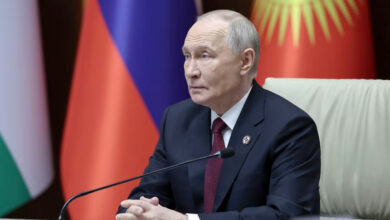
The International Monetary Fund said Monday that it now expects global growth will slow from 3.4 percent in 2022 to 2.9 percent in 2023. That’s up from a forecast of 2.7 percent in October.
The upgrade in the outlook reflects China’s “sudden reopening,” which the IMF said “paves the way for a rapid rebound in activity.” It also cited unexpected resilience in numerous economies in the second half of 2022, as well as an improvement in global financial conditions as inflation starts to ease and the US dollar comes down from its highs.
Official data published Tuesday showed that Europe’s economy managed to eke out growth in the fourth quarter of 2022. GDP growth across the countries using the euro currency was 0.1 percent compared with the third quarter of the year, easing fears of a recession. The annual rate of growth for 2022 was 3.5 percent, according to the preliminary estimate, stronger than the United States or China.
“The outlook is less gloomy than in our October forecast, and could represent a turning point, with growth bottoming out and inflation declining,” Pierre-Olivier Gourinchas, the IMF’s director of research, wrote in a blog post.
The IMF emphasized that growth this year “will remain weak by historical standards.” (Between 2000 and 2019, the annual average was 3.8 percent.)
Central banks will need to continue their aggressive campaign to reduce decades-high inflation, which will result in a slowdown of economic activity. It predicted that “nine out of ten advanced economies will likely decelerate.”
In the United States, growth is expected to slow from 2 percent in 2022 to 1.4 percent in 2023. Europe — whose economy has proved surprisingly hardy despite the region’s energy crisis, in part due to a mild winter so far — is forecast to see growth among the 20 countries that use the euro drop from 3.5 percent to 0.7 percent.
UK outlook deteriorates
The United Kingdom is expected to experience a contraction of 0.6 percent. It’s the only Group of Seven economy projected to shrink this year. A closely-watched survey of executives published last week showed the steepest decline in business activity since the national Covid lockdown two years ago.
Higher interest rates and low consumer confidence are depressing activity in the dominant services sector, while the public sector has been hit by the worst wave of strikes in decades.
Still, the IMF sees some improvements to the global outlook. A major reason is China.
Beijing ended its strict “zero Covid” policy late last year, reopening its borders and moving away from the harsh quarantine and testing policies that had held back growth in the world’s second-largest economy. Its 3 percent expansion in 2022 was one of the country’s worst performances in decades.
The IMF now forecasts growth in China will rebound to 5.2 percent this year, notably higher than its previous estimate.
Inflation trends are also promising. The IMF noted that “overall measures [are] now decreasing in most countries,” even if price increases for goods and services excluding food and energy have yet to peak in many cases. The headline annual reading of US inflation reached a high in June, while inflation in Europe has fallen since October, when it touched a record.
Global inflation is forecast by the IMF to ease from 8.8 percent in 2022 to 6.6 percent in 2023 and 4.3 percent in 2024. Before the pandemic, it was near 3.5 percent.
A pullback in the strength of the US dollar since November, meanwhile, has been helpful for emerging market and developing economies. The greenback’s steep rally had made it more expensive to import commodities, including food and energy, and raised the cost of paying interest on some debt.
Risks to the outlook remain substantial, the IMF warned. China’s recovery could lose steam if future coronavirus waves keep people at home or the vulnerable property sector slows sharply. Inflation could stay elevated for longer than central banks would like, mandating tighter monetary policy. The war in Ukraine remains a key source of uncertainty. An escalation could add to disruptions in food and energy markets.
For now, though, it’s feeling slightly better about the next 12 months — while stressing that they won’t be easy.
“This time around, the global economic outlook hasn’t worsened,” Gourinchas wrote. “That’s good news, but not enough. The road back to a full recovery, with sustainable growth, stable prices and progress for all, is only starting.”




